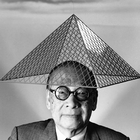
【高翻带你学翻译】外刊精读《现代建筑的最后大师—贝聿铭 》
介绍: 人物小传《现代建筑的最后大师:贝聿铭I.M. Pei 》曾设计卢浮宫金字塔
I.M. Pei, Master Architect Whose Buildings Dazzled the World, Dies at 102
PAUL GOLDBERGER2019年5月17日
I.M. Pei, who began his long career designing buildings for a New York real estate developer and ended it as one of the most revered ar...
介绍: 人物小传《现代建筑的最后大师:贝聿铭I.M. Pei 》曾设计卢浮宫金字塔
I.M. Pei, Master Architect Whose Buildings Dazzled the World, Dies at 102
PAUL GOLDBERGER2019年5月17日
I.M. Pei, who began his long career designing buildings for a New York real estate developer and ended it as one of the most revered architects in the world, died early Thursday at his home in Manhattan. He was 102.
Best known for designing the East Building of the National Gallery of Art in Washington and the glass pyramid at the entrance to the Louvre in Paris, Pei was one of the few architects who were equally attractive to real estate developers, corporate chieftains and art museum boards (the third group, of course, often made up of members of the first two). And all his work — from his commercial skyscrapers to his art museums — represented a careful balance of the cutting edge and the conservative.
Pei remained a committed modernist, and while none of his buildings could ever be called old-fashioned or traditional, his particular brand of modernism — clean, reserved, sharp-edged and unapologetic in its use of simple geometries and its aspirations to monumentality — sometimes seemed to be a throwback, at least when compared with the latest architectural trends. This hardly bothered him. What he valued most in architecture, he said, was that it "stand the test of time."
Pei, who was born in China and moved to the United States in the 1930s, was hired by William Zeckendorf in 1948, shortly after he received his graduate degree in architecture from Harvard, to oversee the design of buildings produced by Zeckendorf's firm, Webb & Knapp.
The Rock & Roll Hall of Fame and Museum project would not be Pei's last unlikely museum commission: His museum oeuvre would culminate in the call to design the Museum of Islamic Art, in Doha, Qatar, in 2008, a challenge Pei accepted with relish. As with the rock museum, Pei saw the Qatar commission as an opportunity to learn about a culture he did not claim to understand. He began his research by reading a biography of the Prophet Muhammad, and then commenced a tour of great Islamic architecture around the world.Besides his many art museums, he designed concert halls, academic structures, hospitals, office towers and civic buildings like the Dallas City Hall, completed in 1977; the John F. Kennedy Library in Boston, finished in 1979. In 1979, the year after the National Gallery was completed, Pei received the Gold Medal of the American Institute of Architects, its highest honor.Pei never played down his connections to China. His children were all given Chinese names, and when he won the Pritzker Prize in 1983, widely viewed as the highest honor a living architect can receive, he used the $100,000 award to establish a scholarship fund for Chinese architecture students.
更多节目 全部>
-
Vol.1556
-
最美英文歌,优雅流行经典《寂静之声》Sound of Silence
Vol.1555
-
【跟《老友记》学美语】92摩擦音 + [L / N] , 寻找落跑钱德勒
Vol.1554
-
Vol.1553




